Data centres are an investment draw…
The show began with two investors on stage, and one of the main themes from their discussion was that even as capital availability shrinks, data centres still attract funding. As they put it on stage, investors want certain, high-quality cashflow., and they get this from data centres. One big reason for this is the upcoming AI compute demand. Although this will eventually touch all areas of digital infra, it is data centres that the cash is hitting first. What this means is millions and millions of new funding from sovereign wealth funds, pension trusts, and other institutional sources – to a level not seen in decades.
…but fibre and subsea not so much
This cash might be getting data centres built, but on the terrestrial fibre and subsea side the picture is not quite as pleasant, with funding hard to come by for some projects (that said, subsea cable construction is not exactly quiet at the moment). There are various reasons for this, delegates heard, mainly related to inefficient business models, pricing not holding up, and a lower return on capex (of which huge amounts are needed) than the data centre side. This is also partly linked to the investor community not giving telcos credit for the huge opportunities around network transformation, where internal industry optimism is not translating to capital inflow.
There is a risk of an imbalanced market…
The above two points present a problem. Effective connectivity is all about the whole network, and if one asset class can get funding and another one can’t, there is a danger that an imbalanced market could cause bottlenecks – new data centres aren’t much use if there isn’t any fibre to connect them. Or, as Morrison’s William Smales put it, “There’s a huge python that has just dislocated its jaw, opened its mouth really wide, and is devouring this AI demand. Data centres have been the head of the snake, but it’s going to ripple through networks and through to the edge. The industry has done a good job in funding data centres, but I’m not sure the conditions are there for the rest of the ecosystem. We’ve got to get it right – otherwise we’re going to have huge indigestion.”
…and this goes for DIB progress, too
The GLF’s fifth diversity, inclusion and belonging annual report was released at ITW this week. The story was one of positives – 80% of respondent companies now track gender diversity – but also negatives, with the focus on racial and sexual orientation diversity falling considerably since 2021. Here’s how Marisa Trisolino, CEO of CMC Networks and Chair of the GLF Diversity, Inclusion, and Belonging Working Group, summarised it: "This year’s report highlights that, whilst for most companies diversity and inclusion is a stated priority, with the exception of gender the diversity axes don’t receive a level of focus that supports this. It also finds that where companies are able to focus and where there is C-Level sponsorship, they make more progress.”
APIs: the hidden revolution
Moving to the operations side, various telco leaders on stage spoke about the huge potential of network APIs to grow telco offerings. APIs give customers direct access to networks to create their own use cases, but reaching critical mass on API use will take much more collaboration between telcos than is happening at present. Customer developers want code and APIs that performs just as effectively, regardless of which telco they got it from, and the value of APIs will be trapped until strong collaboration will make this happen.

AI is making a difference internally
As expected, AI came up again and again in ITW’s discussions, and one interesting angle is the difference that AI use is already making to telco and connectivity operations. The most recent GLF survey data showed that 29% of organisations surveyed have already piloted or fully deployed AI solutions internally, and various use cases, from customer services to data management, are coming to the fore from telcos around the world. This timed nicely with the release of BT’s year-end financial results, in which the telco announced that deploying AI solutions has improved the coding efficiency of its developers by 12% already.
Delayering: get on with it
Delayering (carving out and often disposing of infrastructure layers in a connectivity provider) was another common theme in the chat show – and the main message was that it needs to happen quickly. Bayobab’s Frédéric Schepens talked about MTN’s move to split all infrastructure away from its mobile operators, for example fibre, as the model was no longer working due to capital requirements. This also means a greater chance for open access. MTN opened 112,000 km of proprietary fibre at a stroke, and moves such as this can improve network performance across the board. But if telcos are thinking of delayering, delegates heard, they need to do it fast – otherwise there is a risk of assets becoming stranded.






